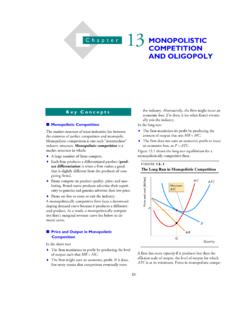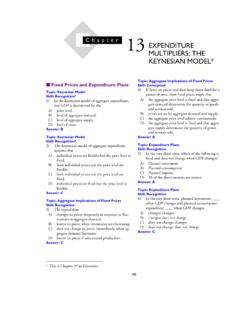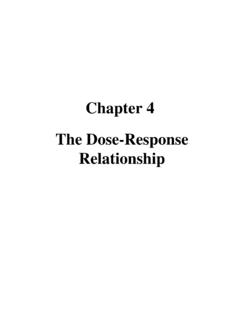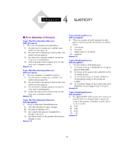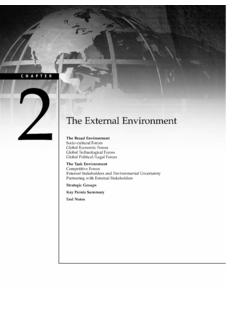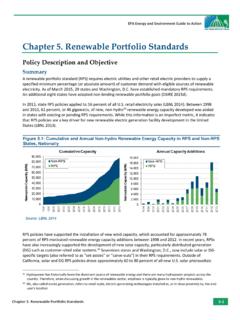Transcription of 12tb700 - Chang Jung Christian University
1 403 12 monopoly market power Topic: market power Skill: Recognition 1) Unregulated monopolies A) take the market price as given. B) cannot incorporate. C) cannot change the market quantity. D) can influence the market quantity and price. Answer: D Topic: How monopoly Arises Skill: Recognition 2) The following are key features of a monopoly EXCEPT A) the monopoly is protected by a barrier to entry. B) no close substitutes exist for the good or service. C) the monopoly has a strong influence over the price of the good or service. D) the monopoly has severe diseconomies of scale. Answer: D Topic: How monopoly Arises Skill: Conceptual 3) Which of the following statements about a mo-nopoly is FALSE? A) Monopolies have no barriers to entry or exit.
2 B) The good produced by a monopoly has no close substitutes. C) A monopoly is the only producer of the good. D) None of the above; that is, all of the above an-swers are true statements about a monopoly . Answer: A Topic: Legal Barriers To Entry Skill: Conceptual 4) Which of the following is LEAST likely to be a monopoly ? A) The holder of a public franchise. B) A pharmaceutical company with a patent on a drug. C) A store in a large shopping mall. D) The sole owner of an occupational license. Answer: C Topic: Legal Barriers To Entry Skill: Recognition 5) A public franchise is A) an exclusive right granted to a firm to supply a good or service. B) a government issued license required to practice a profession. C) an exclusive right granted to an inventor of a product.
3 D) a unique source of raw materials. Answer: A Topic: Legal Barriers To Entry Skill: Conceptual 6) Public franchises create monopolies by restricting A) demand. B) prices. C) entry. D) profit. Answer: C Topic: Legal Barriers To Entry Skill: Recognition 7) A patent grants A) a guarantee of quality to consumers. B) the right to practice a profession. C) an exclusive right to an inventor of a product. D) control over a unique source or supply of raw materials. Answer: C Chapter 404 CHAPTER 12 Topic: Legal Barriers To Entry Skill: Conceptual 8) Patents create monopolies by restricting A) demand. B) prices. C) entry. D) profit. Answer: C Topic: Legal Barriers To Entry Skill: Recognition 9) Patents are ____ barriers to entry and public fran-chises are ____ barriers to entry.
4 A) legal; legal B) legal; natural C) natural; legal D) natural; natural Answer: A Topic: Natural monopoly Skill: Recognition 10) An industry in which one firm can supply the entire market at a lower price than two or more firms can is called a A) legal monopoly . B) natural monopoly . C) single-price monopoly . D) price-discriminating monopoly . Answer: B Topic: Natural monopoly Skill: Conceptual 11) Which of the following is true of a natural mo-nopoly? A) Its long-run average cost curve slopes upward as it intersects the demand curve. B) Economies of scale exist to only a very low level of output. C) The firm can supply the entire market at a lower cost than could two or more firms.
5 D) The firm is not protected by any barrier to en-try. Answer: C Topic: Legal Barriers To Entry Skill: Recognition 12) A market in which competition and entry are restricted by the granting of a public franchise, government license, patent, or copyright is called a A) legal monopoly . B) natural monopoly . C) single-price monopoly . D) price-discriminating monopoly . Answer: A Topic: monopoly Price-Setting Strategies Skill: Conceptual 13) A single-price monopoly charges the same price A) even if the demand curve shifts. B) even if its cost curves shift. C) to all customers. D) and the price equals the firm s marginal revenue. Answer: C Topic: monopoly Price-Setting Strategies Skill: Conceptual 14) All of the following are examples of price dis-crimination EXCEPT A) buy-one-get-one-free offers.
6 B) early bird specials at a restaurant. C) lower ticket prices for matinee performances. D) buy now, pay later payment options. Answer: D monopoly 405 Topic: Natural monopoly Skill: Analytical 15) Given the market demand and cost data in the above figure, the existence of two firms equal sized firms producing a total of 8 million cubic feet of natural gas means that the long-run average cost of producing natural gas is A) 10 cents per cubic foot. B) 20 cents per cubic foot. C) 30 cents per cubic foot. D) 40 cents per cubic foot. Answer: B Topic: Natural monopoly Skill: Analytical 16) Given the market demand and cost data in the above figure, the existence of a monopoly firm producing 8 million cubic feet of natural gas makes it possible to produce natural gas at a long-run average cost of A) 10 cents per cubic foot.
7 B) 20 cents per cubic foot. C) 30 cents per cubic foot. D) 40 cents per cubic foot. Answer: A A Single-Price monopoly s Output and Price Decisions Topic: Price and Marginal Revenue Skill: Conceptual 17) Total revenue equals A) marginal revenue times quantity sold. B) price times quantity sold. C) total cost minus profit. D) the area between the demand curve and the marginal revenue curve. Answer: B Topic: Price and Marginal Revenue Skill: Conceptual 18) For a monopoly , the industry demand curve is the firm s A) supply curve. B) marginal revenue curve. C) demand curve. D) profit function. Answer: C Topic: Price and Marginal Revenue Skill: Recognition 19) Monopolists A) maximize revenue, not profits. B) have no short-run fixed costs.
8 C) face downward sloping demand curves. D) are price takers. Answer: C Topic: Price and Marginal Revenue Skill: Conceptual 20) The marginal revenue curve for a single-price monopoly A) lies below its demand curve. B) coincides with its demand curve. C) lies above its demand curve. D) is horizontal. Answer: A Topic: Marginal Revenue and Elasticity Skill: Analytical 21) For a single-price monopoly , marginal revenue is ____ when demand is elastic and is ____ when demand is inelastic. A) negative; negative B) negative; positive C) positive; negative D) positive; positive Answer: C 406 CHAPTER 12 Topic: Marginal Revenue and Elasticity Skill: Conceptual 22) If the price elasticity of demand is greater than 1, a monopoly s A) total revenue increases when the firm lowers its price.
9 B) total revenue decreases when the firm lowers its price. C) marginal revenue is negative. D) marginal revenue is zero. Answer: A Topic: Marginal Revenue and Elasticity Skill: Conceptual 23) If the price elasticity of demand is less than 1, a monopoly s A) total revenue increases when the firm lowers its price. B) total revenue decreases when the firm lowers its price. C) marginal revenue is undefined. D) marginal revenue is zero. Answer: B Topic: Marginal Revenue and Elasticity Skill: Conceptual 24) If the demand for its product is elastic, a monop-oly s A) total revenue is unchanged when the firm lowers its price. B) total revenue decreases when the firm lowers its price. C) marginal revenue is positive. D) marginal revenue is zero.
10 Answer: C Topic: Marginal Revenue and Elasticity Skill: Conceptual 25) If the demand for its product is inelastic, a mo-nopoly s A) total revenue increases when the firm lowers its price. B) total revenue is unchanged when the firm lowers its price. C) marginal revenue is negative. D) marginal revenue is equal to zero. Answer: C Topic: Marginal Revenue and Elasticity Skill: Conceptual 26) A monopoly firm expands its output and lowers its price. The firm finds that its total revenue falls. Hence, the firm is producing in the A) elastic range of its demand curve. B) inelastic range of its demand curve. C) elastic range of its supply curve. D) inelastic range of its supply curve. Answer: B Topic: Price and Marginal Revenue Skill: Conceptual 27) The figure above shows a monopoly firm s de-mand curve.
